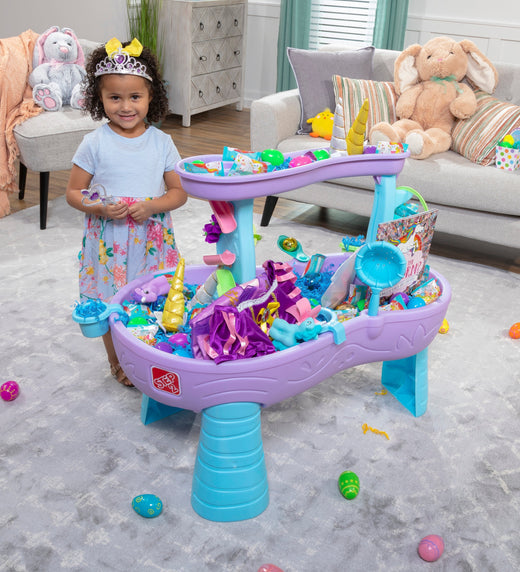
What do dried beans, play balls and rice have in common? They are all household items that can be played with in your kid’s water or sand tables to help foster sensory play!
From an early age it is important that children experience different types of play in order to help them develop and gain skills they will use as they get older. One of those play types is sensory, which encourages kids to use one or more of their senses such as touching, smelling, seeing, hearing or tasting. Sensory play encourages kids to develop cognitively, linguistically, socially and emotionally, physically and creatively.
Below are some fun sensory activities that include your child’s sand or water table and common household products (please note, if your child is under the age of 3, do not allow your child to play with small sensory items that may post a choking hazard):
Dry Beans Sensory Table:

We brought the Wild Whirlpool Water Table inside and placed dry beans to create the perfect sensory experience for little ones. Kids can scoop up beans and place them in the funnel just like they would when this kid’s activity table is filled with water. Now when it is too cold to play outside, you can bring the fun inside and fill this kid’s activity table up with beans!
Tub of Balls:

Grab any type of small play balls you can find lurking around your child’s playroom or bedroom. They can be ping pong balls, tiny bouncy balls, Wiffle balls, ect. – adding all of these different types of balls to the Duck Pond Water Table will make for an exciting and unique sensory adventure. You can slide the balls down the slide, catapult them off the slide flipper and swirl the variety of balls around with the center spinner. Your kids will have a bouncing good time with a water table filled with balls!
Rice Table:

Sensory play activities can be as messy or clean as you want them to be! The original intent of these activity tables is to be played with outside and filled with water or sand. However, when teaching kids about their senses adding different materials such as beans, pasta, rice and balls can help children to better understand sight and touch. There are also plenty of other materials you and your family can use in these activity tables such as: cotton balls, flour, shaving cream, cooked noodles, beads, pebbles, coins or craft pom pom balls.
Have you created your own sensory table before? If so – what have you used to create this experience for your kids?
Step2 always recommends adult supervision during sensory playtime.


